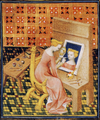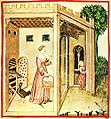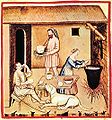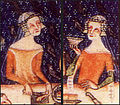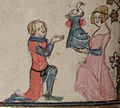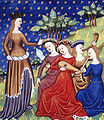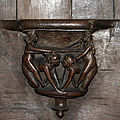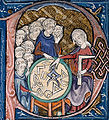- Women in the Middle Ages
-
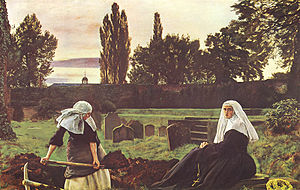 Christian convents in the Middle Ages provided women one alternative to married life.
Christian convents in the Middle Ages provided women one alternative to married life.
Women in the Middle Ages occupied a number of different social roles. Women in the Middle Ages, a period of European history from around the 5th century to the 15th century, held the position of wife, mother, peasant, artisan, and nun, as well as some important leadership roles, such as abbess or queen regnant. The very concept of "woman" changed in a number of ways during the Middle Ages[1] and several forces influenced their role during the period.
Contents
Early Middle Ages (476–1000)
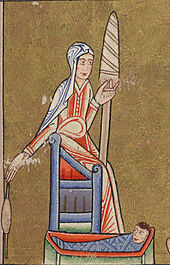 Spinning by hand was a traditional form of women's work (illustration c. 1170).
Spinning by hand was a traditional form of women's work (illustration c. 1170).
The Roman Catholic Church was a major unifying, cultural influence of the Middle Ages with its selection from Latin learning, preservation of the art of writing, and a centralized administration through its network of bishops. Historically in the Catholic and other ancient churches, the role of bishop, like the priesthood, was restricted to men. The first Council of Orange (441) also forbade the ordination of deaconesses, a ruling that was repeated by the Council of Epaon (517) and second Council of Orléans (533).[2]
With the establishment of Christian monasticism, other roles within the Church became available to women. From the 5th century onward, Christian convents provided opportunities for some women to escape the path of marriage and child-rearing, acquire literacy and learning, and play a more active religious role.
Abbesses could become important figures in their own right, often ruling over monasteries of both men and women, and holding significant lands and power. Figures such as Hilda of Whitby (c. 614–680) became influential figures on a national and even international scale.
Spinning was one of a number of traditional women's crafts at this time,[3] initially performed using the spindle and distaff; the spinning wheel was introduced towards the end of the High Middle Ages.
For most of the Middle Ages, until the introduction of beer made with hops, brewing was done largely by women;[4] this was a form of work which could be carried out at home.[3] In addition, married women were generally expected to assist their husbands in business. Such partnerships were facilitated by the fact that much work occurred in or near the home.[5] However, there are recorded examples from the High Middle Ages of women engaged in a business other than that of their husband.[5]
Midwifery was practised informally, gradually becoming a specialised occupation in the Late Middle Ages.[6] Women often died in childbirth,[7] although if they survived the child-bearing years, they could live as long as men, even into their 70s.[7] Life expectancy for women rose during the High Middle Ages, due to improved nutrition.[8]
As with peasant men, the life of peasant women was difficult. Women at this level of society had considerable gender equality,[3] but this often simply meant shared poverty. Until nutrition improved, their life expectancy at birth was significantly less than that of male peasants: perhaps 25 years.[9] As a result, in some places there were 4 men for every 3 women.[9] The late medieval poem Piers Plowman paints a pitiful picture of the life of the medieval peasant woman:
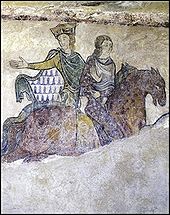 Eleanor of Aquitaine was a wealthy and powerful woman.
Eleanor of Aquitaine was a wealthy and powerful woman.
"Burdened with children and landlords' rent;
What they can put aside from what they make spinning they spend on housing,
Also on milk and meal to make porridge with
To sate their children who cry out for food
And they themselves also suffer much hunger,
And woe in wintertime, and waking up nights
To rise on the bedside to rock the cradle,
Also to card and comb wool, to patch and to wash,
To rub flax and reel yarn and to peel rushes
That it is pity to describe or show in rhyme
The woe of these women who live in huts;"[10]High Middle Ages (1000–1300)
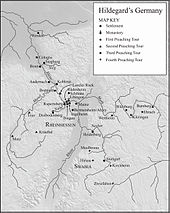 Hildegard of Bingen conducted a number of preaching tours around Germany.
Hildegard of Bingen conducted a number of preaching tours around Germany.
Eleanor of Aquitaine (1122-1204) was one of the wealthiest and most powerful women in Western Europe during the High Middle Ages. She was the patroness of such literary figures as Wace, Benoît de Sainte-More, and Chrétien de Troyes. Eleanor succeeded her father as suo jure Duchess of Aquitaine and Countess of Poitiers at the age of fifteen, and thus became the most eligible bride in Europe.
Herrad of Landsberg, Hildegard of Bingen, and Héloïse d’Argenteuil were influential abbesses and authors during this period. Hadewijch of Antwerp was a poet and mystic.
Constance of Sicily, Urraca of León and Castile, Joan I of Navarre, Melisende of Jerusalem and other Queens regnant exercised political power.
Female artisans in some cities were, like their male equivalents, organised in guilds.[11]
Regarding the role of women in the Church, Pope Innocent III wrote in 1210: "No matter whether the most blessed Virgin Mary stands higher, and is also more illustrious, than all the apostles together, it was still not to her, but to them, that the Lord entrusted the keys to the Kingdom of Heaven".[12]
Late Middle Ages (1300–1500)
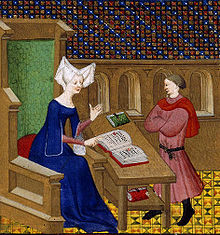 Christine de Pizan became a professional writer after the death of her husband in 1390.
Christine de Pizan became a professional writer after the death of her husband in 1390.
In the Late Middle Ages women such as Saint Catherine of Siena and Saint Teresa of Avila played significant roles in the development of theological ideas and discussion within the church, and were later declared Doctors of the Roman Catholic Church. The mystic Julian of Norwich was also significant in England.
Isabella I of Castile ruled a combined kingdom with her husband Ferdinand II of Aragon, and Joan of Arc successfully led the French army on several occasions during the Hundred Years' War.
Christine de Pizan was a noted late medieval writer on women's issues. Her Book of the City of Ladies attacked misogyny, while her Treasure of the City of Ladies articulated an ideal of feminine virtue for women from walks of life ranging from princess to peasant's wife.[13] Her advice to the princess includes a recommendation to use diplomatic skills to prevent war:
"If any neighbouring or foreign prince wishes for any reason to make war against her husband, or if her husband wishes to make war on someone else, the good lady will consider this thing carefully, bearing in mind the great evils and infinite cruelties, destruction, massacres and detriment to the country that result from war; the outcome is often terrible. She will ponder long and hard whether she can do something (always preserving the honour of her husband) to prevent this war."[14]
From the last century of the Middle Ages onwards, restrictions began to be placed on women's work, and guilds became increasingly male-only.[11] Female property rights also began to be curtailed during this period.[15]
Medieval representations of female activities
-
Hildegard of Bingen
receiving divine inspiration. -
Christine de Pizan
lecturing to a group of men. -
Misericord picturing a fictional joust between two naked women, each straddling a man.
See also
- Female education (Medieval)
- Medieval literature (Women's)
- Prostitution (Middle Ages)
- Women artists (Medieval)
- Women in Judaism (Middle Ages)
- Women in science (Medieval)
- Timeline of women in medieval warfare
- Clothing:
- Early medieval European dress
- 1100–1200 in fashion
- 1200–1300 in fashion
- 1300–1400 in fashion
- 1400–1500 in fashion
References
- ^ Allen, Volume 2, The Early Humanist Reformation, Part 1, p. 6.
- ^ Herbert Thurston, "Deaconesses", Catholic Encyclopedia (1908), http://www.newadvent.org/cathen/04651a.htm
- ^ a b c Pat Knapp and Monika von Zell, Women and Work in the Middle Ages.
- ^ Schaus, p. 13.
- ^ a b Schaus, p. 44.
- ^ Schaus, p. 561.
- ^ a b Albrecht Classen, Old age in the Middle Ages and the Renaissance: interdisciplinary approaches to a neglected topic, Walter de Gruyter, 2007, ISBN 3110195488, p. 128.
- ^ Shulamith Shahar, tr. Yael Lotan, Growing Old in the Middle Ages: 'winter clothes us in shadow and pain', 2nd ed., Routledge, 2004, ISBN 0415333601, p. 34.
- ^ a b Williams and Echols, p. 241.
- ^ William Langland, tr. George Economou, William Langland's Piers Plowman: the C version : a verse translation, University of Pennsylvania Press, 1996, ISBN 0812215613, p. 82.
- ^ a b Schaus, p. 337.
- ^ Innocent III, Epistle, 11 December 1210
- ^ Allen, Volume 2, The Early Humanist Reformation, Part 2, p. 646.
- ^ Christine de Pizan, tr. Sarah Lawson, The Treasure of the City of Ladies, or The Book of the Three Virtues, Penguin Classics, 2003, ISBN 0140449507, p. 22.
- ^ Erler and Kowaleski, p. 198.
Major Sources
- Allen, Prudence, The Concept of Woman: Volume 1, The Aristotelian Revolution, 750 BC-AD 1250, 2nd ed., Eerdmans, 1997, ISBN 0802842704.
- Allen, Prudence, The Concept of Woman: Volume 2, The Early Humanist Reformation, 1250-1500, Part 1, Eerdmans, 2006, ISBN 0802833462.
- Allen, Prudence, The Concept of Woman: Volume 2, The Early Humanist Reformation, 1250-1500, Part 2, Eerdmans, 2006, ISBN 0802833470.
- Erler, Mary Carpenter Erler and Maryanne Kowaleski, Gendering the Master Narrative: Women and power in the Middle Ages, Cornell University Press, 2003, ISBN 0801488303.
- Schaus, Margaret, Women and gender in medieval Europe: an encyclopedia, CRC Press, 2006, ISBN 0415969441.
- Williams, Marty and Anne Echols, Between Pit and Pedestal: Women in the Middle Ages, Markus Wiener, 1994, ISBN 0910129347.
Categories:- Middle Ages
- Medieval women
- Women in history
- Christianity and women
Wikimedia Foundation. 2010.

